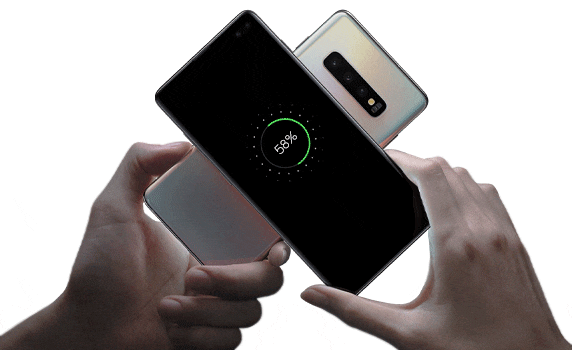The S10 allows device-to-device charging without the need for a charger. You can also charge your S10 and another device at the same time.
Optimised battery performance
The Galaxy S10 uses artificial intelligence that learns your behaviour, so that it can automatically adapt to power-saving modes and restrict less frequently used apps to maintain power for longer.
Device-to-device charging
If the battery on your device is getting low, automatically transfer power from your S10. Simply activate “Wireless PowerShare” on your notification panel, then place the other device on the centre of your S10 with their backs facing.
Please note: The location of the charging coil may vary by device model. You may need to adjust the devices until they connect with each other properly.

Separate the devices when enough power has been transferred, or wait until the other device is fully charged.
Dual charging
Whilst your S10 is plugged in using wired charging, you can charge another device at the same time.

Follow the below steps to activate dual charging:
1
Pull down the notification panel on your S10 and tap the Wireless PowerShare icon to switch it on.
2Put the centre of the S10 back-to-back with another device.
3The screen will confirm once the devices are connected. Tap “OK”.
4
If you pull down the notification panel again a message will show that it is charging the connected device. The Wireless PowerShare icon will also appear on the status bar or on your Always On Display panel.
Please note: Depending on the type of accessories or phone covers being used, the Wireless PowerShare feature may not work properly. It is recommended to remove any accessories or phone covers before using Wireless PowerShare. Only devices that support wireless charging can be charged using this feature. The charging speed or efficiency may vary depending on the device’s condition or the surrounding environment.
- Get link
- X
- Other Apps
- Get link
- X
- Other Apps
Comments
Post a Comment